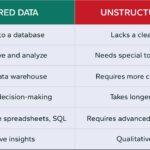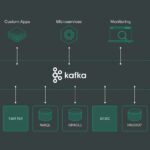In the realm of Big Data, the process of cleaning and organizing large datasets is crucial to ensure accurate and reliable outcomes. Automated data cleaning, powered by artificial intelligence (AI), has emerged as a transformative solution to deal with the complexities and scales of Big Data. By leveraging AI algorithms and machine learning techniques, organizations can streamline the data cleansing process, identify and rectify inconsistencies, and enhance the overall data quality. This article explores the pivotal role of AI in automated data cleaning within the realm of Big Data, highlighting its impact on improving data accuracy, optimizing analytical insights, and driving informed decision-making.
Understanding Data Cleaning in the Context of Big Data
Data cleaning, a fundamental aspect of data processing, involves identifying and rectifying errors or inconsistencies in datasets. In the world of Big Data, where volumes of data are enormous and complex, ensuring data quality is paramount. Poor data quality can lead to misguided insights, affecting crucial business decision-making processes. Automated data cleaning uses various technologies, including Artificial Intelligence (AI), to enhance efficiency in managing these large datasets.
The Challenges of Data Cleaning in Big Data
Data cleaning in Big Data poses unique challenges due to:
- Volume: The sheer size of the data makes manual cleaning impractical.
- Variety: Data comes in various formats, from structured data in databases to unstructured text in emails and social media.
- Velocity: Data is generated in real-time, requiring immediate cleaning to maintain its relevancy.
- Veracity: Ensuring the accuracy and reliability of data due to potential noise is a critical issue.
The Emergence of AI in Data Cleaning
AI technologies leverage machine learning algorithms and natural language processing (NLP) to understand and cleanse data. These tools analyze datasets more quickly and accurately, identifying patterns and anomalies that might go unnoticed by traditional methods. The integration of AI in automated data cleaning presents several advantages:
1. Enhanced Accuracy and Precision
AI models are designed to learn from large datasets. They can improve the accuracy of data cleaning processes over time by refining their algorithms based on historical cleaning data. For example, when an algorithm identifies a specific kind of error, it can adjust its parameters to minimize similar errors in future datasets.
2. Scalability
As businesses accumulate more data, the scalability of data cleaning solutions becomes crucial. AI-driven tools can automatically adapt to increasing volumes of data, offering processing capabilities that stay effective, regardless of the size of the dataset. This scalability ensures that companies do not need to invest increasingly more resources as their data grows.
3. Reducing the Manual Effort
The automation of data cleaning processes through AI minimizes the need for manual intervention. This not only saves time but also reduces the potential for human error. Data scientists and analysts can focus on more strategic tasks rather than spending time on tedious, repetitive cleaning activities.
4. Predictive Cleaning Capabilities
AI can anticipate potential future data irregularities based on historical patterns, making it possible to apply corrective measures even before problems arise. Predictive cleaning capabilities enable organizations to maintain high data quality proactively, rather than reactively.
5. Handling Unstructured Data
One of the most significant challenges in Big Data is accurately processing and cleaning unstructured data. AI-powered techniques, like NLP, can automatically categorize, tag, and clean unstructured data sources, transforming them into structured datasets. This capability increases the usability of otherwise challenging data sources, such as customer feedback or social media content.
AI Techniques in Automated Data Cleaning
Various AI techniques are employed in automated data cleaning, including:
1. Machine Learning Algorithms
Machine learning algorithms can be trained to recognize and correct errors based on previous data cleaning tasks. For instance, a supervised learning model can be trained on a labeled dataset, where the cleaned and uncleaned parts are identified, allowing the model to learn the difference and apply this knowledge to new data.
2. Natural Language Processing (NLP)
NLP tools analyze textual information and can identify errors such as misspellings, grammar issues, or contextually incorrect phrases. This is particularly useful in cleaning data from social media, emails, and feedback forms where the language can be informal and varied.
3. Clustering and Classification
AI uses clustering techniques to group similar data points, which can help identify anomalies or outliers that need to be cleaned. Classification models can assign labels to data based on predefined categories, aiding in the identification of dirty data.
4. Regular Expressions
Although not exclusive to AI, regular expressions are often used in conjunction with machine learning to identify patterns in data. This is particularly useful for cleaning and validating strings, such as phone numbers or email addresses.
Tools and Platforms Leveraging AI for Data Cleaning
Several tools and platforms seamlessly integrate AI capabilities for automated data cleaning, including:
- Talend: Provides data integration and management tools that include AI-driven data cleaning capabilities.
- Trifacta: An interactive tool that enhances data preparation and cleaning utilizing machine learning to automate repetitive tasks.
- Apache Spark: With built-in machine learning libraries, Spark enables distributed data cleaning processes across large datasets.
- Pandas: A widely-used Python library for data manipulation that incorporates various functions for cleaning and transforming datasets efficiently.
The Future of AI in Automated Data Cleaning
The future of AI in data cleaning looks promising, with continual advancements in machine learning, NLP, and integrative technologies. Here are some anticipated trends:
1. Improved Interoperability
AI tools will increasingly focus on interoperability with other data processes, making it easier to clean, analyze, and visualize data. Advanced APIs and integrations will enable more seamless data workflows.
2. Greater User Accessibility
As user-friendly AI solutions emerge, non-specialists will find it easier to engage in data cleaning without requiring extensive background knowledge in data science. This democratization of data cleaning will enhance overall data quality across organizations.
3. Continuous Learning and Adaptation
Future AI models will benefit from continuous learning capabilities, allowing them to adapt and improve in real-time as new data becomes available. The focus will be on creating systems that can refine their cleaning processes dynamically.
4. Ethical Data Cleaning Practices
As the importance of ethical data handling grows, AI tools will start integrating fairness and bias detection features into their cleaning processes. Ensuring data is representative and free from bias will be a priority for organizations leveraging AI for data cleaning.
Conclusion & Key Takeaways
AI’s role in automated data cleaning is multifaceted, offering significant improvements in accuracy, scalability, and efficiency for handling Big Data. As organizations continue to rely on data-driven insights for strategic decisions, the importance of effective data cleaning—facilitated by AI—becomes increasingly vital. Investing in AI-driven data cleaning solutions will not only streamline data quality processes but also empower organizations to make better, informed decisions based on high-quality data.
The integration of AI in automated data cleaning processes within the realm of Big Data has proven to be a game-changer in enhancing the efficiency, accuracy, and scalability of data cleaning tasks. By leveraging AI algorithms and machine learning techniques, organizations can significantly reduce manual intervention, mitigate errors, and uncover valuable insights from massive datasets in a timely manner. As the volume and complexity of data continue to grow, the role of AI in automated data cleaning will be increasingly vital for organizations aiming to harness the full potential of Big Data analytics.














